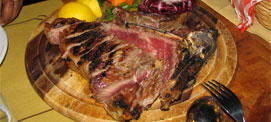cooking lessons tuscany - italian cooking - cooking classes tuscany - italian cooking vacation - wine tasting tuscany - tuscany vacations - gourmet cooking - cooking school
Florentine steak the queen of meat

The expert culinary Pellegrino Artusi, in his essay "The science of cooking and the art of eating well", defines the turning of the steak so: "Florentine steak. From beef-steaks, the English word is true rib of beef, is derived the name of our steak, which is nothing more than a cutlet with a bone, a large finger or a finger and a half, cut from the loin of veal".
The history of the Florentine steak is as old as much as the city from which it takes its name and if they lose track back in time. However, his tradition, his celebrity and his name can be traced back to the celebration of the feast of San Lorenzo and the Medici family. At San Lorenzo, 10 August, the city was illuminated with the light of huge bonfires, where they were roasted large quantities of veal, which was then distributed to the population.
Florence of the Medicis at the time was an important crossroads where you could meet travelers from some from all over the world and so it is said that at San Lorenzo were present at the celebrations some English knights who were offered the roasted meat the fires. They called it in their language referring to the beef steak type of meat they were eating. From here a translation adapted to the current language created the word steak which has come down to this day.
An alternate version of the traces to the English present in Florence in '800, which have left deep traces in Tuscan cuisine. They were wealthy individuals who could afford fine cut of meat such as beef steak, of course, but also as the roast beef, however, also present in Florentine cuisine.